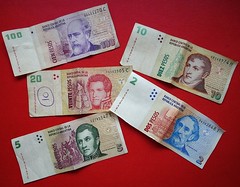We're pretty good at managing credit and debit cards for traveling. We don't pay annual fees or foreign transaction fees, we've never paid an ATM charge that wasn't rebated, we've switched to chipped cards when offered, and we even get one to two percent cash back.
But none of that is relevant in Argentina right now, where cash, physical money, is king. I won't try to explain the complicated Argentine economic situation -- google the news for a thousand varying explanations, if you're interested -- but I will try to give an idea of how it affects our daily life during our month in Buenos Aires.
The government here manipulates the currency exchange rate, meaning that the peso's official value in dollar terms does not reflect its true purchasing power. When we've visited in the past (most recently in 2011), the difference between the official rate and the black market rate (the so-called dolar blue) was not big enough to concern us. We used our credit and debit cards and all was fine. Lately, however, because of the financial turmoil in Argentina, the spread between the official and unofficial exchange rate is widening almost every day. As I write this, the 'official' exchange rate is 8.39 pesos per U.S. dollar, while the unofficial dolar blue rate (compra, buying pesos) is 13.53 per U.S. dollar. That means the dolar blue is more than 60% higher than the official rate.
If you use a credit or debit card to buy something, you'll pay at the official rate. A liter of milk at the nearby Carrefour supermarket is 16 pesos, or $1.90US. But if you could pay at the dolar blue rate, it's $1.18US. An even better example is our dinner last night, when we had a large pizza and a liter of beer at Romario's. The total bill with a tip of more than 10% was 200 pesos; officially that's $23.85, but in dolar blue it's $14.80. Think of it this way: using dolar blue is like having a 40% off coupon for everything in Argentina.
Now comes the tricky part: how do you trade your dollars for pesos at the dolar blue rate? For that you have to find a cueva (cave), a place that trades pesos for dollars. Since this black market currency trading is technically illegal, cuevas do not advertise and are not clearly marked with a big sign out front "Get Your Pesos Here!" Instead they are regular shops, selling jewelry or mobile phones or houseware. The fact that they trade currency spreads by word of mouth and nothing is ever written down. And illegal or not, they are everywhere, a pervasive element of life in Argentina to which the authorities turn a blind eye.
So, you ask your neighbors and friends and shopkeepers if they know of a trusted neighborhood cueva. They'll tell you about a place around the corner or down a block or two, where you'll take your crisp new $100US bills and lay out two or three or four of them on the counter and ask what rate they're offering today. (Used bills and those of smaller denominations might work, but you wouldn't get as good an exchange rate.) The rate you get will be close to, but a bit less than, the posted dolar blue compra rate. The cueva takes your dollars and gives you big wads of Argentine 100 peso bills. (Although the inflation rate is horrible, the government refuses to print any bill larger than 100 pesos, worth about $7.50US, as it would be a tacit admission that inflation has gotten out of control.)
Trading dollars for pesos is incidental for casual visitors like us, but it's survival for Argentines. Because of numerous economic crises over the decades, many people here have saved up U.S. dollars whenever possible to protect themselves during peso devaluations like now. While the government is down to less than $30 billion U.S. in hard currency reserves, various estimates put the total amount of U.S. dollars held privately in Argentina at $100 to $200 billion.
Besides the cuevas there are also arbolitos (little trees, so-called because they stand outside covered with the green leaves of currency), guys who walk around shouting Cambio! Cambio! Cambio! But the arbolitos and the cuevas on Florida Street downtown cater mostly to tourists and there is much greater risk of getting falsos (counterfeit bills). (I wrote about the problem of phony bills in Argentina back in 2009. Nowadays the incentive for making counterfeits is greatly reduced because even the largest bills are worth so little.)
Currency trading for day-to-day expenses is certainly more exciting than simply handing over a piece of plastic to buy stuff. Leave the credit cards at home and bring $100 bills. Don't exchange more than a few hundred at a time because you never know whether the rate will go up or down. If the dolar blue goes up, stores and restaurants will get cheaper for those with dollars because they can't raise prices fast enough to keep up.
It's a bit of a game for travelers like us, trying to get best deal for our dollars. But it's serious business for Argentina where unemployment and inflation are rising and most people are just trying to get by.
